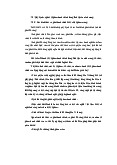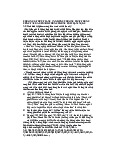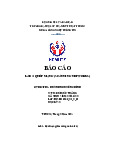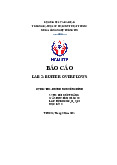






Preview text:
Journal of Physics: Conference Series PAPER • OPEN ACCESS
Design of neural network and PLC-based water flow controller
To cite this article: Burhanuddin Ahmad and Prawito Prajitno 2020 J. Phys.: Conf. Ser. 1528 012065
View the article online for updates and enhancements.
This content was downloaded from IP address 158.46.213.203 on 10/06/2020 at 13:39 4t
h International Seminar on Sensors, Instrumentation, Measurement and Metrology IOP Publishing
J ournal of Physics: Conference Series 1528 (2020) 012065
doi:10.1088/1742-6596/1528/1/012065
Design of neural network and PL - C based water flow controller
Burhanuddin Ahmad and Prawito Prajitno*
Department of Physics, Faculty of Mathematics and Natural Sciences, Universitas Indonesia, Depok, Indonesia *prawito@sci.ui.ac.id
Abstract. Flow rate is a fundamental physical quantity in the fluid transportation system from
one place to another. To achieve this, a reliable controller that is able to produce a constant
flowrate in industry is needed. The most used flow controllers in industries are PID-based
controllers that are implemented using PLCs. However, there are still shortcomings, they can
perform poorly in some applications, for example in the highly nonlinear system which cannot
be overcome by conventional PID controllers. There are some other limitations of PID
controller, such as PID has the overshoot and undershoots in the output of controlled system
and PID gives late response in this study, a neural network-based flow controller is proposed to
deal with that problems. The controller will be operated in a miniature plant which consists of a
water tank, water pump, a control valve, and a flow transmitter. Due to PLC limitation that
cannot be programmed with common programming languages such as MATLAB, a personal
computer (PC) is used to run the proposed neural network controller. The PC communicates
with the PLC using OPC (OLE for Process Control) server, while the PLC reads the flow
transmitter and also controls the control valve directly based on the result output of the neural
network controller. In order to evaluate the performance of the proposed controller, several
experiments have been conducted. The performance of the proposed controller has been
compared with the conventional PID controller. It shows that neural network-based controller
outperformed the conventional PID controller, in terms of maximum overshoot and steady-
state error, where the neural network controller has maximum overshoot = 5.36% and steady-
state error = 0.85%, while the PID controller has 11.3% for overshoot and 1.10 % for steady- state error. 1. Introduction
PID control offers the simplest and yet most efficient solution to many real-world control problems. It
is report that more than 90% of industrial control er are stil implemented based around PID algorithm
[1]. This PID control parameters consists of three types, namely Proportional term (K ), Integral term p
(K ), and Derivative term (K ). Al the three parameters can be adjustable and used together or I D
individual y such as Proportional, Proportional Derivative (PD) and Proportional Integral (PI)
control ers, depending on the response we want to a plant. The transfer function of series PID
control er is shown by equation 1 H(s) = Kp+ Ki + K s Ds (1)
Content from this work may be used under the terms of the Creative Commons Attribution 3.0 licence. Any further distribution
of this work must maintain attribution to the author(s) and the title of the work, journal citation and DOI.
Published under licence by IOP Publishing Ltd 1 4t
h International Seminar on Sensors, Instrumentation, Measurement and Metrology IOP Publishing
J ournal of Physics: Conference Series 1528 (2020) 012065
doi:10.1088/1742-6596/1528/1/012065
However, in the term of implementation to the plant there is lack of understanding on tuning
procedures which means the methods of adjusting the parameter PID controller sometimes have
difficulty to determine which value is suitable for those three PID control parameters. Determining the
PID control parameters is very important things for control the whole process because it effects on
performance factors at transient response and the error of the system. Neural Network (NN) has
become tremendously popular in the control application due to its ability in adaptive learning based on
data and approximating function [2]. It is one of the artificial representations of the human brain that
always tries to simulate the learning process as in the human brain [3]. Research on neural network as
a controller still continuing to develop and it has been proven that neural network is able to be a
controller that can minimize errors and to estimate the output value under different conditions based
on the identification of the process at linear as well as nonlinear system by implementing the inverse
NN and back-propagation algorithm as a training method [4]. Furthermore, the researchers
implemented a NN, as a controller in the tank heating system which is stirred continuously. In this
system which is very susceptible to interference and has high sensitivity of process dynamics, the
researchers used a combination of the Adaptive Linear Element (Adeline) approach with NN-based
controller as an optimization variable to hold disruptions and problems that occur in non-linear systems [5].
Besides being used as a single controller, NN can also be used combined with conventional PID
controllers as done in [6]. In that research study, the PID tuning parameter as a NN input quantity of
the network that will be optimize and the results will be used to control piston movement and
compensate for the effect of congenital pressure in a way implementing the inverse neural network
model. In industrial implementation, NN has also been used for predicting errors and monitoring the
work of PLC. NN algorithm is used to analyze the received signal processing from the sensors and the
execution process of the PLC program. Through a monitoring process of the PLC program, the
possibility of errors that will occur can be seen so that it can be detected easily [7].
Based on the successful implementation of NN in controllers that presented above, in this research
study a NN-based controller is proposed to control the water flow rate in a prototype plant that uses an
accurate low-cost flow transmitter and a control valve. The objective of this study is on NN
development to become a controller based on a first-order with dead time plant model. The
development begins with the use of Ziegler-Nichols method in open-loop system to construct a PID
controller in the prototype plant. Based on the available sequential process variables (PV) data in
conjunction with their set-points (SP) data and the associated manipulated variables (MV) data, an NN
Model was then built to predict manipulated variable (MV) to control the flow rate of the plant.
2. Design and Implementation
2.1. Lab scale experimental setup
The design of this system consists of hardware and PVC pipes ½ inch in diameter as the process
connection. The length of the pipeline used in the system ± 15 meters from the tank to back to the
tank. A Process and Instrumentation Diagram is visualized in Figure 1 corresponds to the maintenance
and modification of the pipelines transport system for envisioning the physical sequences of
equipment used in the lab-scale experimental setup as shown in Figure 2.
The lab scale set up has some transmitter include pressure transmitter (PT001) and flow transmitter
(FT001). At the end equal percentage flow characteristic control valve (CV) is implemented and flow
transmitter (FT) has been placed. The controller section includes flow indicating controller (FIC) to
control the control valve as manipulated variable (MV). PLC mounted FIC decides the level of control
valve opening which this FIC is not accessible by the operator which is tuned by PLC-PID controller
for operation in the pipeline transport system. 2 4t
h International Seminar on Sensors, Instrumentation, Measurement and Metrology IOP Publishing
J ournal of Physics: Conference Series 1528 (2020) 012065
doi:10.1088/1742-6596/1528/1/012065
Figure 1. P&ID Diagram for experimental setup Figure 2. Experimental setup
2.2. Programming end communication setup
Programming setup in this project consists of two parts, there are the design of the ladder diagram in
the Speed PLC software to program the PLC, and the design of Matlab/SIMULINK to apply the
developed NN controller such as in Figure 4. This software design influences each other because the
Matlab software requires address as a reference address on the PLC to acquire measured data on the
flow transmitter and pressure transmitter. This data will be processed using the de developed NN
algorithm in the Matlab software.
Figure 3. Communication flow diagram 3 4t
h International Seminar on Sensors, Instrumentation, Measurement and Metrology IOP Publishing
J ournal of Physics: Conference Series 1528 (2020) 012065
doi:10.1088/1742-6596/1528/1/012065
For implementing the NN algorithm to PLC we need an interface or medium for connecting
between PLC and MATLAB as shown in Figure 3. The writer used OPC server to connect it. OPC
Server (Object Linking Embedded for Process Control Server) is interface software using a client /
server mode based on COM (Component Object Model) / Distributed Component Object Model) that
allows MATLAB to communicate with the PLC. The advantages of OPC servers in the process of
integrating between PLC and MATLAB directly, which can reduce the level of complexity of the
system, facilitate the plant simulation process, reduce additional hardware on the PC, and reduce costs [7].
Figure 4. NN Control SIMULINK model
2.3. Developing Neural Network Controller
Figure 5. Block diagram of NN model learning
The NN learning model that is used in building the NN controller in this research study is shown in
Figure 5. The training data are obtained from the MATLAB simulation on the previous PID control
that is used as the model desired. The data used for the training process are PV (k-1), PV (k), and SP
data and MV (k) data as target data. NN learning will minimize the error between the PV (k+1) of the
Model and PV (k+1) generated from the plant. The index k in the variable means that data is taken at
the time sampling k, while (k-1) means that data is taken previously.
After training the NN, then the developed neural network models used as a controller in the system
as shown in Figure 5. The Matlab function gensim(output) is used to generate the SIMULINK block as shown in Figure 4 [8] [9]. 4 4t
h International Seminar on Sensors, Instrumentation, Measurement and Metrology IOP Publishing
J ournal of Physics: Conference Series 1528 (2020) 012065
doi:10.1088/1742-6596/1528/1/012065 3. Result and discussion
Table 1. Performance analysis of PID Control er Set Point Max Overshoot Error Settling Rise Time Time 70% 7% 1.1% 9.24s 7.26s 50% 15.310% 1.09% 18.36s 5.16s 80% 11.836% 1.13% 10.38s 8.22s
Figure 6. Performance comparison between PID and NN-based control er
Table 2. Performance analysis of NN-Control er Set Point Max Overshoot Error Settling time Rise time 70% 4.6% 0.8% 9.84s 8.46s 50% 5.36% 0.85% 8.4s 8.22s 80% 4.29% 0.08% 11.4s 9.96s
By comparing the performance of the two controller above as shown by Table 1 and Table 2, it can
be concluded that NN-based controller has better performance than the conventional PID controller,
especially in the terms of its maximum overshot and its steady-state error, where in the average NN-
based controller can reduced the maximum overshoot of the plant by 5.94%, as well as in term of
steady-state error NN-based controller can make it lower. In terms of the other performance
parameters, both controllers have almost the same performance.
It can be seen from the results of the two controller as shown in Figure 6, that the flow transmitter
gives fluctuation flow reading. It is due to the flow of the water flow in the pipe of the real plant and
also the flow transmitter that has low accuracy and low precision but it shows that the proposed NN-
based controller capable of successfully handling this uncertainty by giving better performance in
controlling the flow-rate. This result is consistent with the results that have been reported in [2] [8]. 4. Conclusion
From this study, after experimenting, collecting and analyzing data, it can be concluded that NN-based
controller has better performance than PID controller in terms of maximum overshoot and steady-state
error. This result shows that NN is able to deal with the uncertainty (noise) of the plant because of a
low accuracy and precision sensor used in it. 5 4t
h International Seminar on Sensors, Instrumentation, Measurement and Metrology IOP Publishing
J ournal of Physics: Conference Series 1528 (2020) 012065
doi:10.1088/1742-6596/1528/1/012065 Acknowledgment
This work is supported by research grant of Indexed International Publication of Student Final Project
(Hibah Publikasi Internasional Terindeks untuk Tugas Akhir (PITTA) Mahasiwa), Universitas
Indonesia, Grant No. NKB0657/UN2.R3.1/HKP.05.00/2019. References
[1]. Ang, Kiam Heong, Gregory Chong, and Yun Li. "PID control system analysis, design, and
technology." IEEE transactions on control systems technology 13.4 (2005): 559-576.
[2]. May, Zazilah, Muhammad Hanif Amaran, and Nor Aisyah Ghazali. "Neural network predictive
control er for pressure control." Proceedings of the 10th WSEAS international conference on
Computational Intel igence, Man-Machine Systems and Cybernetics, and proceedings of the
10th WSEAS international conference on Information Security and Privacy. World Scientific
and Engineering Academy and Society (WSEAS), 2011.
[3]. Liu, Jinkun. Intel igent Control Design and MATLAB Simulation. Singapore: Springer Singapore, 2018.
[4]. Priyanka, E. B., C. Maheswari, and S. Thangavel. "Online monitoring and control of flow rate
in oil pipelines transportation system by using PLC based Fuzzy‐PID Controller." Flow
Measurement and Instrumentation 62 (2018): 144-151.
[5]. Priyanka, E. B., C. Maheswari, and B. Meenakshipriya. "Parameter monitoring and control
during petrol transportation using PLC based PID control er." Journal of applied research and
technology 14.2 (2016): 125-131.
[6]. S. ANUSHA, G. KARPAGAM & E. BHUVANESWARRI. “Comparison of Tuning Methods
of Pid Controller.” BEST: International Journal of Management, Information Technology and
Engineering (BEST: IJMITE) 2.8 (2014): 1–8. BEST: International Journal of Management,
Information Technology and Engineering (BEST: IJMITE). Web.
[7]. Lieping, Zhang, Zeng Aiqun, and Zhang Yunsheng. "On remote real-time communication
between MATLAB and PLC based on OPC technology." 2007 Chinese Control Conference. IEEE, 2007.
[8]. Vamvoudakis, K. G., F.L. Lewis, and Shuzhi Sam Ge. “Neural Networks in Feedback Control
Systems.” Mechanical Engineers’ Handbook. John Wiley & Sons, Inc., 2015. 1–52. Mechanical Engineers’ Handbook. Web.
[9]. Demuth, Howard, M Beale, and M Hagan. “Neural Network ToolboxTM 6.” User’s guide
(2008): n. pag. User’s guide. Web.
[10]. “Process Control.” Mineral Processing Design and Operations. Elsevier, 2016. 763–816.
Mineral Processing Design and Operations. Web. 6




